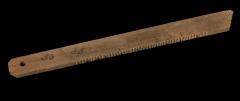ENGLAND: THE OTHER WITHIN
Analysing the English Collections at the Pitt Rivers Museum
Hop tallies
Alison Petch,
Researcher 'The Other Within' project

1902.51.7 Hop tally of rectangular light coloured wood. Notched on one edge, hole bored in one end, and angle carved on the othe
The use of hops (humulus lupulus) in making beer was first introduced into England from the Netherlands in the fifteenth century. [Roud, 2006: 286] Hop-growing quickly became an important agricultural activity. Kent is the most famous county for growing hops in England but quite a few other counties have grown hops. Hops are grown up poles and wires and picked in September.
For most crops either a migrant population of men were used or the farms' own hands but hops have a short picking season and had to be picked by hand so migrant workers had to be used and whole families would be involved, because women and children could do the work as well as men. One of the most famous sources of migrant hop-pickers were people from the East End of London who used to move to Kent for the picking season. Hop-picking, though it was considered suitable for women and children, was not easy work. Roud quotes one Kent villager:
The smell of hops was really overpowering and a few people, my mother and myself among them, were quite badly affected, feeling sick and faint for the first few days after which we became immune to the smell. [2006: 287]
Once the hops were picked they were taken to oast-houses to be dried.
According to Roud:
Hop-picking naturally had its own traditional customs, modelled on those of other seasonal agricultural tasks, such as the hop-pickers' feast to celebrate the end of the season, and the election of a king and queen of the hop-fields. A traditional way of greeting a stranger, or punishing some minor transgression of hop-field etiquette, was by 'cribbing' them - bundling them into one of the hop bins. [2006: 287]
By the middle of the twentieth century hop picking machines were used and the hop-pickers' way of life ended.
We have 105 hop tallies and tokens from England in the Pitt Rivers Museum, they come from Kent, Herefordshire, and East Sussex. Once the hops had been picked into baskets or bins, they were measured into bushels for the "tally basket" at the end of the row of hops:
The 'tally man' came round at intervals during the day, when the hops would be measured out by the tally and recorded for each family. They were then transferred to the oast house in huge 'pokes' known as 'green bags', each containing 12 bushels, by horse-drawn farm wagons. Pickers were paid by the bushel and an average pick would be 25 bushels a day. One shilling (5p) per bushel is the highest pay recorded and for many years it was only eight old pence.
[source Faversham Hop Festival accessed 18.1.08]
At the end of the picking season the tallies could be exchanged for cash.
In most instances our tallies come in two halves, as the accession book entry describes for 1913.25.1-23:
23 wooden tallies, notched, used upon a hop farm near Maidstone, Kent. The larger halves are all threaded upon a cord for convenience in carrying about by the overseer on his rounds, the smaller halves were kept by the hop-pickers.
These tallies were donated by the then Curator of the Pitt Rivers Museum, Henry Balfour, in 1913.
Another tally entry explains:
'Hop-growers' Tally-Stick and "Tokens" from Boughton-Blean, East Kent. 1902': "The hops in this district are picked into baskets (not bins) & each notch on the "tally" represents one basket of 5 Bushels. The blackened notches show the number of baskets picked in one day. As the hops must be dried as soon as possible (before they begin to wither) & the "Osts" can only hold a limited quantity, the pickers are often obliged to cease work for an hour or two - At a given signal the tally-man goes to each basket & gives the picker a token representing the quantity then in it. The baskets are painted in rings inside to indicate the measure in bushels - beginning at 1/2 bush. & so on up to 5 bush. Which is the full basket. The picker keeps the token until work is resumed & when the basket is full returns the token to the tally-man & has a notch filed on his "tally". The five bushel token is only used when the Tally-man is too hurried to notch the sticks.' [Accession book entry for 1902.51.7, tally from Boughton Blean, East Kent donated in 1902 by Miss F.(possibly Florence) E. Ogden.]
Our tallies are made from wood. The tokens were made from metal:
5 circular metal tokens representing portions of basket of hops picked from 1/2 basket to 1, 2, 4 and 5 bushels. 5 bushels = a whole basket, and this is worth one notch on the tally. Boughton Blean, East Kent [Accession book entry for 1902.51.8-12]
According to Issue Thirty One Leaden Tokens Telegraph Hop tallies were used in conjunction with the tokens and were made from wood.
The tally man retained the larger piece and the picker the smaller, every 5 bushels being represented by a notch cut in both sticks, which obviously had to match.
Hop tokens were issued in significant numbers between 1780 and the early 1940s. The conversion rate from bushels into cash depended upon the quality and quantity of the crop picked.
Further reading
Hop picking
http://en.wikipedia.org/wiki/Hop_plant
http://en.wikipedia.org/wiki/Oast_house
http://www.geocities.com/transport_and_society/hopping.html